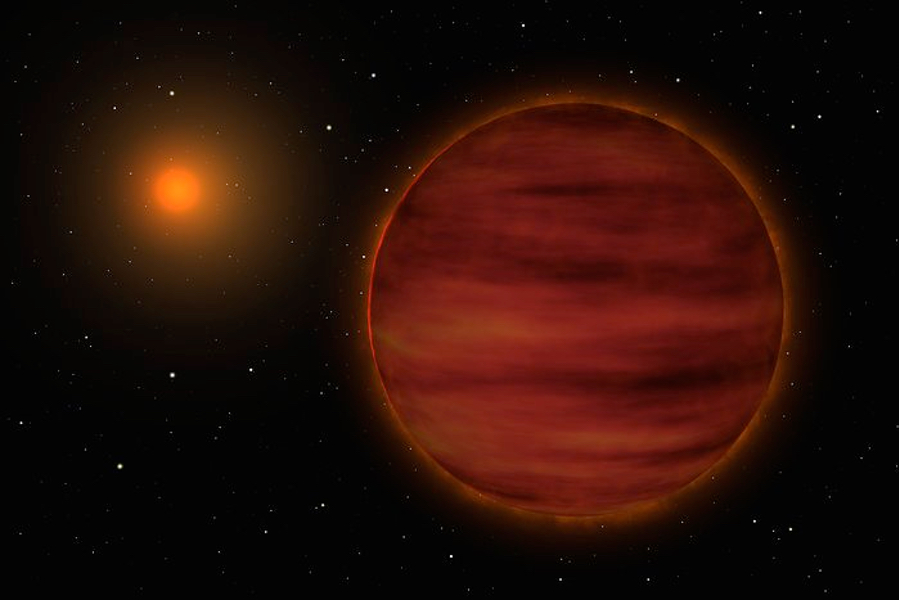- About▼
- Exo 101▼
- News
- Research▼
- Jobs + Internships▼
- Public Outreach▼
- Our Team▼
- Contact Us
- FR▼

An international team led by researchers from the Institute for Research on Exoplanets has discovered a brown dwarf near a small star called TOI-1278. Although they are relatively easy to discover, few such systems have been identified, suggesting that they are particularly rare.
TOI-1278 is located about 245 light-years from Earth in the constellation Cygnus. It is a small star about half the mass of the Sun; such stars are called red dwarfs. These stars are common in the solar neighborhood and represent more than 75% of the stars around us. Astronomers are particularly interested in these stars because it is easier to detect companions – especially small Earth-like planets – around these stars than for larger ones.
In the summer of 2019, TOI-1278 was observed by NASA’s Transiting Exoplanet Survey Satellite (TESS), which aims to detect exoplanets around the stars closest to the Sun. These observations allowed to identify two small decreases in the brightness of the star, possibly due to the presence of a companion periodically passing in front of it.
To confirm it was indeed a companion, observations were made in the fall of 2019 at the Wild Boar Remote Observatory in Italy and using the 0.91-meter telescope at the M.G. Fracastoro Station of the Catania Astrophysical Observatory, also in Italy. The team confirmed the presence of a companion with a period of 14.5 days. This short period indicates that the companion is very close to its host, about 0.1 astronomical unit, which is four times less than the distance between Mercury and the Sun.

The optical system of the SPIRou spectrograph on the cryogenic bench in the IRAP/OMP clean room. (Credit: S. Chastanet/CNRS/UPS/OMP)
The next step was to determine the mass of the companion in order to specify its nature: was it a gas giant planet or a brown dwarf, a star with an intermediate mass between planet and star?
The team, led by Étienne Artigau, researcher at the Institute for Research on Exoplanets, used SPIRou (for SPectropolarimètre InfraRouge) to observe the system, between May and November 2020. This instrument, installed at the Canada-France-Hawaii Telescope (CFHT), was specifically designed to make radial velocity measurements on low-mass stars to find and characterise companions, notably as part of the SPIRou Legacy Survey.
The more massive a companion is, the more it affects the velocity of its star. SPIRou can measure the variation in the speed of stars by decomposing their light to obtain their spectrum. When a star approaches the Earth, the light waves it emits are stretched, and the lines of its spectrum are red-shifted. When it approaches, it is the opposite: its lines are shifted towards the blue.
“For TOI-1278, we quickly knew that the companion was massive: we could see the lines of the spectrum moving with the naked eye,” explains Étienne Artigau. “By analysing the data, we determined that the companion, TOI-1278B, is a brown dwarf about 18 times the mass of Jupiter.”
Companions like TOI-1278 B are quite easy to spot around small stars. However, very few are known, suggesting these systems are very rare. The very massive planets and brown dwarfs that have been found around red dwarfs are typically much further from their host. This is the case with GU Piscium b, a planet of about 10 times the mass of Jupiter that is located at 2000 astronomical units from its star, a discovery also made by iREx researchers.
This scarcity is consistent with the predictions of formation models. The pair formed by the star TOI-1278 and the brown dwarf TOI-1278B presents a challenge for theorists, who can’t easily explain how it could have formed. It is expected that companions form either as planets, in a protoplanetary disc, or as stars. However, TOI-1278B is too massive to have formed like a planet, but too light to have formed in a similar way to a star. It is a mystery that remains to be solved!
“And it’s not over yet,” concludes Étienne Artigau. “We have 300 nights of observation with the SPIRou Legacy Survey which are largely devoted to studying planetary systems around red dwarfs. Several discoveries as surprising as TOI-1278B are certainly to come!”
“TOI-1278 B: SPIRou unveils a rare Brown Dwarf Companion in Close-In Orbit around an M dwarf”, by Étienne Artigau et al., was published on October 1st, 2021, in the Astronomical Journal. In addition to Étienne Artigau, the team includes Charles Cadieux, Thomas Vandal, Neil J. Cook, René Doyon, Jonathan Gagné, Farbod Jahandar, David Lafrenière, Lison Malo, Jason Rowe, and Stefan Pelletier from iREx, and 31 other co-authors from France, Brazil, Italy, the United States, Portugal, Switzerland and Chile.
You must be logged in to post a comment.